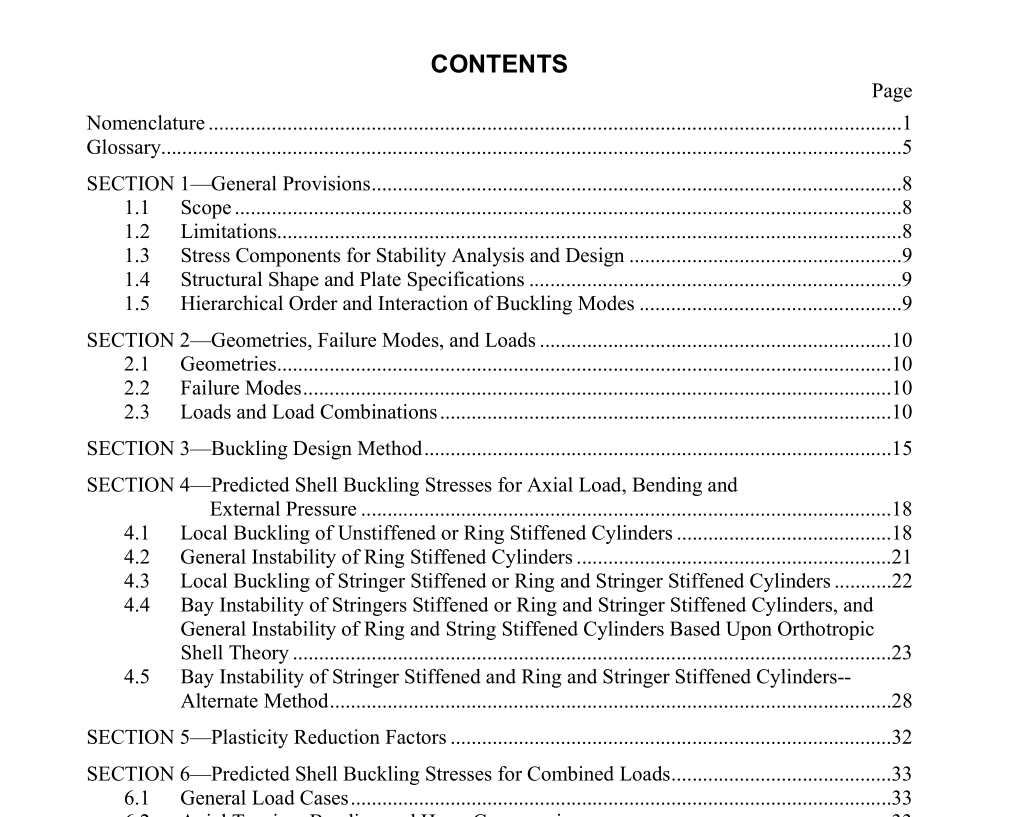API BULL 2U pdf download

API BULL 2U pdf download.Bulletin on Stability Design of Cylindrical Shells
effective width : The reduced width of shell or plate which, with an assumed uniform stress distribution, produces the same effect on the behavior of a structural member as the actual width of shell or plate with its nonuniform stress distribution. elastic buckling stress : The buckling stress of a cylinder based upon elastic behavior. general instability : Buckling of one or more circumferential (i.e., ring) stiffeners with the attached shell plate in ring-stiffened cylindrical shells. For a ring- and stringer-stiffened cylindrical shell general instability refers to the buckling of one or more rings and stringers with the attached shell plate. hierarchical order of instability : Refers to a design method that will ensure development of a design with the most critical instability mode (i.e., general instability) having a higher critical buckling stress than the less critical instability mode (i.e., local instability). hydrostatic pressure : Uniform external pressure on the sides and ends of a member. inelastic buckling stress : The buckling stress of a cylinder which exceeds the elastic stress limit of the member material. The inelastic material properties are accounted for, including effects of residual stresses due to forming and welding. interaction of instability modes : Critical buckling stress determined for one instability mode may be affected (i.e., reduced) by another instability mode. Elastic buckling stresses for two or more instability modes should be kept apart to preclude an interaction between instability modes. local instability : Buckling of the shell plate between the stiffeners with the stiffeners (i.e., rings or rings and stringers) remaining intact.
1.1 SCOPE
1.1.1 This Bulletin provides stability criteria for determining the structural adequacy against buckling of large diameter circular cylindrical members when subjected to axial load, bending, shear and external pressure acting independently or in combination. The cylinders may be unstiffened, longitudinally stiffened, ring stiffened or stiffened with both longitudinal and ring stiffeners. Research and development work leading to the preparation and issue of all three editions of this Bulletin is documented in References 1 through 16 and the Commentary. 1.1.2 The buckling capacities of the cylinders are based on linear bifurcation (classical) analyses reduced by capacity reduction factors which account for the effects of imperfections and nonlinearity in geometry and boundary conditions and by plasticity reduction factors which account for nonlinearity in material properties. The reduction factors were determined from tests conducted on fabricated steel cylinders. The plasticity reduction factors include the effects of residual stresses resulting from the fabrication process. 1.1.3 Fabricated cylinders are produced by butt-welding together cold or hot formed plate materials. Long fabricated cylinders are generally made by butt-welding together a series of short sections, commonly referred to as cans, with the longitudinal welds rotated between the cans. Long fabricated cylinders generally have D/t ratios less than 300 and are covered by AP RP 2A.
1.2 LIMITATIONS
1.2.1 The criteria given are for stiffened cylinders with uniform thickness between ring stiffeners or for unstiffened cylinders of uniform thickness. All shell penetrations must be properly reinforced. The results of experimental studies on buckling of shells with reinforced openings and some design guidance are given in Ref. 2. The stability criteria of this bulletin may be used for cylinders with openings that are reinforced in accordance with the recommendations of Ref. 2 if the openings do not exceed 10% of the cylinder diameter or 80% of the ring spacing. Special consideration must be given to the effects of larger penetrations. 1.2.2 The stability criteria are applicable to shells with diameter-to-thickness (D/t) ratios equal to or greater than 300 but less than 1200 and shell thicknesses of 5 mm (3/16 in.) or greater. The deviations from true circular shape and straightness must satisfy the requirements stated in this bulletin, refer to section 10.









